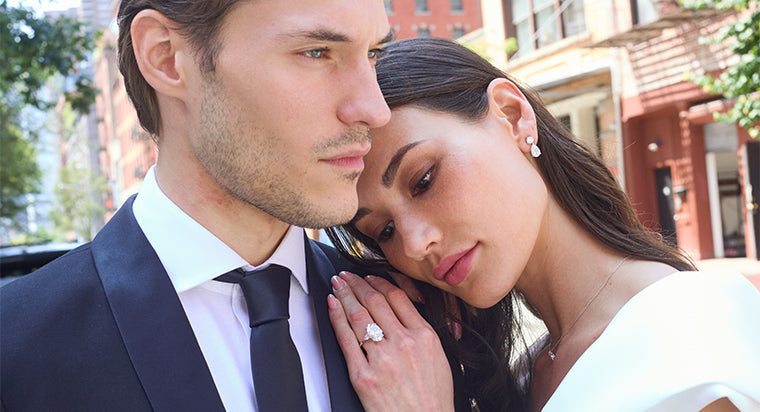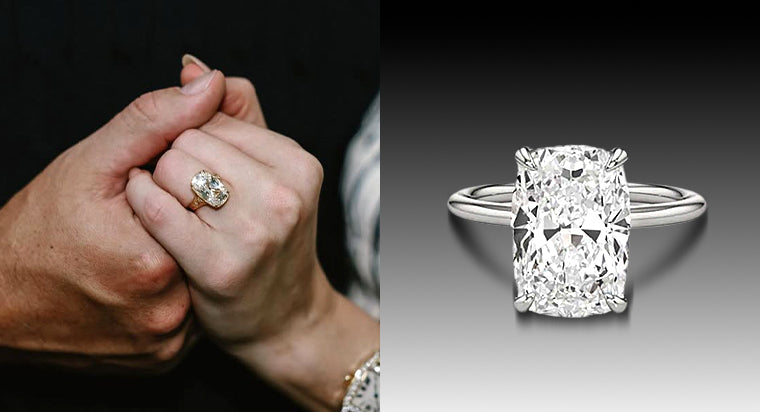Engagement Rings 101

Deciding to propose to the woman of your dreams is exciting. It can also be nerve-wracking. You're wondering if she'll say yes, how and where to pop the question — and that ain't the half of it. Once you've decided to propose, it's time for another big decision: buying an engagement ring. Lucky you! We've made it easy with this comprehensive guide. Think of it as your Engagement Ring 101.
With so many engagement ring styles to choose from, it can be difficult to know where to start. You'll need to consider a fair amount of information before determining which ring will be perfect for your fiancée and future wife – because it’s something she'll look at daily for a lifetime. Start this important journey right, with our review of the types of engagement rings available today.
TABLE OF CONTENTS
The Parts of an Engagement Ring
An engagement ring contains several components, and it's helpful to know the terminology. Engagement rings have a head, mounting, shoulder, side stones (not always), prongs, a peg, and shank.
- Head: The head is the part that holds the diamond, and is usually 14k gold (white).
- Prongs: The prongs are part of the head and comprise most of it. They hold the diamond. There are usually four or six prongs on a head.
- Peg: The peg is located in the base of the head and plants a hole in the diamond to keep it securely in place. Not all heads have a peg.
- Mounting or Setting: This refers to the entire ring minus the diamond.
- Shoulder: This is the portion of the ring beside the main diamond where additional stones may be set. It usually rises higher than the rest of the band.
- Side Stones: Engagement rings may or may not have side stones. Solitaires do not have side stones.
- Shank: This refers to the band that makes up the bottom of the ring that wraps around the bottom of the finger.
Popular Engagement Ring Metal Settings
Some people believe that buying an engagement ring is as simple as picking out a gold ring and a stone, but the truth is, there's a lot of choice. For many years, 14-karat yellow gold was the standard, but today couples can choose wedding bands and engagement rings in a variety of metals.
- Two-Tone: Two-tone rings include two different types of metals, such as yellow and white gold, gold and platinum, or even gold and titanium.
- Yellow or White Gold: Rings in this type of metal usually come in 10k, 14k or 18k. 14- and 18-karat gold are recommended, as they're the optimal blend of quality, purity and visual appeal.
- Platinum: Platinum rings are usually more expensive because it takes more of that dense metal to create a band. They're a good choice for someone who's looking for a more durable band as platinum does not scratch as easily. Platinum will develop a patina over time, which is a duller shine than white gold.
It is possible to re-polish gold and platinum rings and return them to their original appearance. With regular care and cleaning, both metals can look beautiful for a lifetime.
How to Buy An Engagement Ring: Tips
When buying an engagement ring, it's important to consider the style preferences of the bride-to-be (if you know them), your budget, and the quality of the diamond (if you're buying a diamond ring). These essentials will help guide you to the right choice.
Bride-to-be: Try to figure out what she likes by being observant or asking friends or family. Does she adore solitaires or love rings with side stones? Did she once mention that she would love a ring like Kate Middleton’s?
Budget: Buy the most beautiful ring you can within your budget. Your bride will appreciate you for making the effort (but she probably won't be thrilled if it takes ten years to pay it off).
Diamond Quality: Understand the 4 Cs of a diamond so you ensure that you're getting a quality stone. Choosing a diamond that has been certified by GIA is important, so you can be sure of the value of the diamond and its quality. Other laboratories don't have standards as strict as GIA and may not be as trustworthy.
Diamond Engagement Ring Alternatives: Gemstone Rings
When buying an engagement ring with an alternative to a diamond, there are several choices. Some women would prefer a gemstone for a variety of reasons, and these rings can be just as beautiful. Popular gemstone alternatives include emerald, sapphire and ruby, which are rare and valuable — in fact, many carry a price tag even higher than that of a diamond. These gemstones are chosen for their color, while diamonds are chosen for their sparkle. In terms of durability, gemstones are slightly softer than diamonds. This means they're not indestructible, but with regular care, they can be worn for a lifetime.
Although not all brides follow trends, it can be helpful to know the most common styles of engagement rings.
- Twisted and woven band designs are a popular choice for those looking to symbolize the intertwining of their lives.
- Engagement rings with tiny surprise details — sometimes as simple as tiny diamonds set into the prongs — can add a unique and memorable touch.
- Three-stone styles are always a popular choice, with a main center stone and smaller stones on either side. These represent the past, present and future of the couple.
- The solitaire, with one stone set in a prong setting, is always a popular choice. It allows you to spend the bulk of your budget on a beautiful center stone.
- Geometrical design rings are becoming more popular among those looking for a contemporary style. Asymmetrical diamond accents and geometrical shapes can help make the engagement ring really stand out.
- Fancy accents are also a popular choice today, with side stones in a variety of shapes to accent the main diamond. These add flair to the engagement ring but can also increase the cost.
Regardless of the final choice, it's important to remember that this ring will remain on her finger for the rest of her life, symbolizing the love and commitment two people have for each other. It’s worth taking a little time and effort to make an informed decision, incorporating her style and preference if possible.
FAQs
What are the main parts of an engagement ring?
An engagement ring typically consists of three main parts: the band, the setting, and the center stone.
Which are the popular metals for an engagement ring?
The most popular metals for an engagement ring are platinum and white gold, followed by yellow gold and rose gold.
Which stone can be used instead of a diamond for an engagement ring?
There are several stones that can be used instead of a diamond for an engagement ring, such as moissanite, sapphire, emerald, ruby, and aquamarine. It all comes down to personal preference and budget.
What do three-stone engagement rings symbolize?
Three-stone engagement rings are said to symbolize the past, present, and future of a relationship. The three stones can also represent friendship, love, and fidelity or the couple's journey together, with the center stone representing the present moment.
When should I buy an engagement ring?
The timing of when to buy an engagement ring can vary based on individual circumstances and preferences. However, some common factors to consider are:
1) When you are ready to propose to your partner and have discussed marriage and future plans together.
2) When you have saved enough money or have a budget in mind for the ring.
3) When you have researched and found the right style and type of ring that your partner would love.
4) If you are planning a surprise proposal, consider the timing for the occasion, such as a special date or a memorable location.
Overall, the best time to buy an engagement ring is when you feel confident and excited about proposing and are prepared to make the commitment to your partner.









